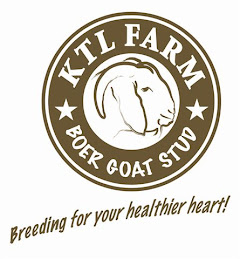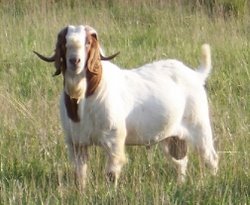| by Gail Bowman |
| The demand for `chevon', or `cabrito', or `goat meat' in the United States is so high that producers can't keep up. Because of this vacuum, much of the goat meat sold in the United States is imported from New Zealand or Australia. About 1.5 million pounds of goat meat is imported every week. And demand just keeps growing. |
| Much of the demand is generated by the changing ethnic demographics of the continent. About 63% of the red meat consumed worldwide is goat! Much of the goat meat demand in the United States comes from ethnic groups that include Middle Eastern, Asian, African, Latin American and Caribbean heritage. Most of these groups buy goat meat whenever they can find it, and they are willing to pay better prices for higher quality meat. |
| What is so special about chevon (goat meat)? Many people have digestive problems that require a careful diet. The molecular structure of chevon is different than that of other meats. Therefore, chevon digests more easily. It is also a low fat, good tasting alternative to chicken or fish. I am one of those people who have to watch what they eat. I can eat chicken, some kinds of fish, turkey and chevon. I prefer chevon from an animal that is at least 75% Boer. The Boer influence changes the taste of the meat to a milder, more veal-like flavor. When you have as few choices in your diet as I do, you learn what you like. I have not had the opportunity to try Kiko or Fainting goat meat. My comparisons are with dairy goat meat. |
| The Direct Market Niche and the Commercial Meat Herd In our area, if you put out the word that you have meat goats for sale, you usually have enough calls to sell your animals right off your ranch. I get about $1.00 per pound on the hoof. I have had other breeders tell me that they can get more for goats with Boer blood. This is a good example of one way to market your goats - find a profitable direct market niche. |
| One of the most popular market niches in the meat goat industry today is the direct market. A `direct market' is a group or type of buyer that will come directly to your ranch to buy from you, for a specific reason. There are many direct market niches for meat goats. I have already suggested one type of direct market niche: the ethnic meat market. Another direct market niche involves the growing trend in the 4-H and FFA clubs to raise meat goats. One of the most profitable direct market niches supplies Chevon to the local restaurants that are serving an ethnic clientele. Another direct market niche is the market for meat breeding stock. Commercial meat breeders will usually pay about double, for breeding stock, what you might have expected to receive for the same animal by the pound. |
| Many breeders are now working together, in cooperatives or associations, to meet large commercial sales contracts. These contracts supply the meat markets on the east and west coasts of the United States, and require a supply of high numbers of animals, of a consistent quality, on a regular basis. At this time, much of the meat for these contracts is being imported because there just are not enough meat goats in the United States to supply the contracts. |
| In many areas of the country, slaughter houses are being constructed specifically for goat meat. However, almost none of the goats being processed at these facilities are actually meat type goats. There are just not enough meat goats being raised, which are not pre-sold to direct markets, to supply a production facility. |
| Fullblood Meat Goats |
| There are several types of 'meat' goats: Boer goats, Tennessee Fainting Goats, Kiko goats, and 'Spanish' goats. However, only three of these are true breeds with breed associations and standardized meat breed characteristics. These are the Boers, Kikos and Tennessee Fainting goats. The 'Spanish' goats are an indigenous goat of the southern United States. There are a couple of breeders who have done a terrific job of breeding these animals up into a very good meat animal. However, no registry or breed standards have been developed at the time of this printing. |
| Boer goats are large framed animals resembling, in many ways, the Nubian goat. The most striking difference between a Boer goat and any other type of goat you may have seen, is the size. A Boer is a large, double muscled animal developed in Southern Africa specifically for meat and hardiness. They can consistently produce more muscling in less time than any other breed of goat, and will pass this capability to their kids. Boers are vibrantly colored and relatively uniform throughout. They are easy to raise, have mild temperaments, are affectionate, require no milking, no special care, no shearing, and no fancy fences. Boers and Boer crosses also have huge rumen capacity. The Boer goats were developed to clear land that was too difficult to be cleared by humans. They spend a lot more time grazing than other types of goats do. One reason for this, is that they are out grazing in the heat of the day when dairy goats are wilting in the shade. They are also out grazing when the snow is blowing across the pasture. They will graze and thrive on ground that will not support dairy goats without supplementation. |
| The Kiko goat is a recent development of a New Zealand company called "Goatex Group LLC". These hardy goats were developed as a result of a government funded project to get the native goat population in New Zealand under control. As part of this project, in the 1970's, many goats were hunted and killed, and thousands more were captured to cross with angoras. Some of the native goats confined during this project exhibited enhanced characteristics for growth and meat production. The members of Goatex isolated these animals and began to cross them with hair and milk goats to find a combination that would yield the best results in both hardiness and meat carcass production. The resulting breed was called "Kiko" meaning "meat for consumption" in Maori. |
| Fainting goats are not huge animals. They average between 17 and 25 inches tall, and weigh between 50 and 165 pounds. They come in a wide variety of coats and colors, with long ears that stand out to the sides of their heads. Fainting goats have very distinctive 'bulgy' eyes. Several breeders have spent a lot of time and energy breeding this basic breed up into an 'improved' meat goat that is larger and heavier and crosses well with Boers. |
| Fullblood breeding animals are a whole different industry from the meat production industry. However, the two are very closely tied. When you take a look at what you want to raise, you might consider adding at least a few quality fullbloods to your operation. If the meat industry in your area blooms and expands, there will be more demand for good fullblood meat goats. We are heading into an era of serious meat production. |
| In all livestock industries, there is a place for the good registered herd sire. These animals must be proven to be fertile and prolific, adaptable, disease free, and have the meat and muscle characteristics that will add productivity to a commercial meat herd. It may be a good idea to consider whether or not you want to make the initial investment to start a good breeding stock herd. Or, alternatively, add a few breeding stock to your meat herd, or some meat production stock to your fullblood herd. The two types are not mutually exclusive. As a matter of fact, one usually leads to the other. If you start with a meat herd, but have to add a fullblood herd sire, sometimes you will also be tempted to buy a fullblood doe to go with him. Then you are suddenly producing herd sires for your neighbors. This is a good idea, because one good fullblood sale a year can pay nearly 1/5th of your feed costs for a year (if you are raising 50 goats). |
| What are the prices on fullblood meat goats expected to be in the long run? Many things will affect the answer to that question. I know a couple who breed fullblood registered angus cattle. How many rural communities have plenty of cattle? How can these people make their money? They market. They have big production sales where breeders come from all over the world, or tie into a satellite link, to buy their stock. I believe that there will always be top breeding stock. People that advertise, raise quality disease free animals, and let the meat producers know they are out there, will always have a market. |
| As in all industries, the price you will be able to get for good fullblood stock will depend on the quality of your animals and the effectiveness of your advertising. If you do not want to market, you will probably be able to sell your fullbloods to your neighbors at about $250 each, indefinitely. If you are well known, and advertise, and you have animals that make the buyer's head turn, you will probably always be able to get at least $800 for your fullblood meat goats. At the time of this printing the prices for good fullblood stock are about double that amount, and are actually going up. These prices have been stable for three years now, and the market seem to indicate that they will remain firm in the future. |
| Whether you are interested in raising goats for meat or for breeding, or some combination of the two, meat goats, and goat meat, are here to stay. The market is increasing and expanding, and shows no signs of slowing down. You don't need a lot of specialized equipment to raise meat goats, and you can reasonably plan to raise about 6 does with their kids per acre of good edible vegetation. As an industry, meat goats are replacing beef, hogs and dairy herds nation wide. Meat goats are the newest and fastest growing small acreage industry in the United States. |
| This article is an excerpt from the new book, Raising Meat Goats for Profit by Gail Bowman. |

